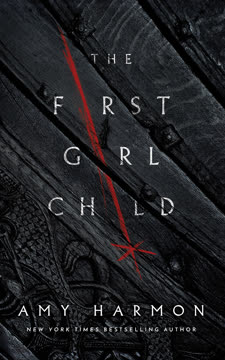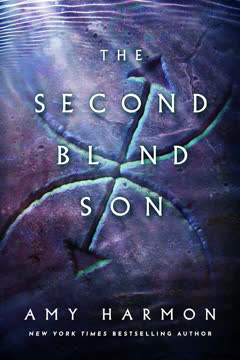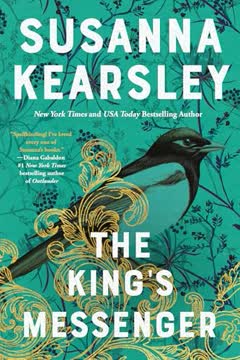Plot Summary
Runes and Bloodlines
In the land of Saylok, six clans are bound by ancient runes and the will of the gods. Siblings Dagmar and Desdemona discover a cave of forbidden runes, awakening a sense of destiny and danger. The runes, powered by blood, are both a source of wisdom and a harbinger of doom. The children's encounter foreshadows the intertwining of their fates with the land's future. The runes' power is mysterious, accessible only to those with "rune blood," and their misuse can bring calamity. This secret knowledge, and the siblings' bond, set the stage for a story where prophecy, sacrifice, and the struggle for power will shape the destiny of Saylok and its people.
The Temple Boy's Burden
Years later, Dagmar becomes a keeper, seeking wisdom over war, while Desdemona, a fierce warrior, is trapped by the ambitions of men. When Desdemona, betrayed and dying after childbirth, entrusts her newborn son Bayr to Dagmar, she curses the land: no daughters will be born in Saylok. Her blood rune, drawn in agony, seals a prophecy that only her son can break the curse. Dagmar, torn between duty and love, raises Bayr in the temple, hiding his origins and the burden of Desdemona's dying words. The boy's fate is entwined with the land's, and Dagmar's devotion becomes both shield and shackle.
A Curse on Daughters
As Bayr grows, Saylok suffers. No daughters are born for years, and the clans grow desperate, raiding and trading for women from distant lands. The people's hope turns to fear, and the keepers' prayers go unanswered. Bayr, marked by strength and silence, becomes a legend—the Temple Boy—while Dagmar's guilt festers. The curse's grip tightens, and the land's future is imperiled. The prophecy of salvation through Bayr looms, but the path is unclear. The absence of daughters becomes a symbol of the land's spiritual and moral decay, and the people's faith in the gods and the keepers begins to waver.
The Birth of Bayr
Bayr, raised in the temple by Dagmar, grows into a boy of prodigious strength but struggles to speak. His stutter is a constant reminder of his difference, but his heart is gentle and loyal. The keepers marvel at his abilities, and the people whisper of miracles and curses. Bayr's only solace is his bond with Dagmar and, later, with Alba, the first girl child born in years. The boy's destiny is shaped by love, loss, and the weight of expectations he cannot understand. His journey is one of self-discovery, humility, and the search for belonging in a world that both fears and needs him.
The King's Deceit
Banruud, chieftain of Berne, is consumed by the desire for power. When a slave girl from Eastlandia gives birth to a daughter, Alba, Banruud claims the child as his own, passing her off as the daughter of his wife, Alannah. He orchestrates the deaths of those who know the truth, ensuring his path to the throne. Alba's birth is hailed as a miracle, ending the drought of daughters, and Banruud is crowned king. Yet his reign is built on lies, betrayal, and blood. The true mother, Ghost, is left bereft, watching from the shadows as her child is raised as a princess, her own identity erased.
The Only Girl Child
Alba grows up in the palace, beloved by the people and protected by Bayr, who becomes her constant companion and silent guardian. Their bond is deep and pure, forged in innocence and need. Ghost, Alba's true mother, lingers on the fringes, her love both a comfort and a torment. The keepers, led by Ivo and Dagmar, sense Alba's importance but do not know her origins. The land's hope is pinned on her, but the curse remains unbroken. The king's paranoia grows, and the threat of violence and exposure hangs over all. The stage is set for a reckoning between truth and power.
The Daughters of Freya
In a desperate attempt to appease the gods and secure the future, each clan sends a daughter to the temple to be raised as a supplicant. These girls—Elayne, Juliah, Liis, Bashti, and Dalys—join Alba, forming a new sisterhood under Ghost's care. The temple becomes a haven for the lost and the exiled, a place of learning, healing, and quiet rebellion. The girls, each with unique gifts and wounds, are shaped by their shared suffering and the guidance of Ghost and Dagmar. Their presence rekindles hope, but also stirs jealousy, fear, and the king's desire to control the fate of Saylok's women.
Ghosts and Keepers
Ghost, the pale shepherdess, becomes a keeper in all but name, guiding the daughters and aiding the temple. Her bond with Dagmar deepens into love, though both are bound by vows and fears. Ghost's true identity as Alba's mother is a secret she guards fiercely, even as the king's suspicions grow. The keepers struggle to balance tradition with necessity, teaching the girls the ways of the runes while fearing the consequences. The temple is both sanctuary and prison, and the lines between past and present, truth and deception, blur. The keepers' power wanes as the king's tyranny grows.
The Weight of Prophecy
As Bayr comes of age, his strength and humility make him a natural leader, but the king's hatred forces him into exile. Dagmar, torn between love and duty, sends Bayr to Dolphys, where he is claimed as chieftain. Alba, left behind, mourns his absence, her heart aching for the only person who truly sees her. The prophecy of salvation through Bayr haunts them all, but the path is fraught with pain and sacrifice. The curse persists, and the land's divisions deepen. The keepers' faith is tested, and the bonds of family, love, and loyalty are stretched to the breaking point.
Love and Sacrifice
Bayr and Alba, reunited at last, confess their love, only to be torn apart by the revelation that they are siblings—an untruth planted by Banruud to keep them apart. The king's machinations reach their zenith as he arranges Alba's marriage to the North King, Gudrun, in exchange for peace. Ghost reveals the truth of Alba's parentage, shattering the king's hold and freeing Bayr and Alba from the lie that binds them. Dagmar, wounded and weary, prepares for a final act of sacrifice to break the curse and save Saylok. Love, in all its forms, becomes the crucible in which fate is forged.
The Tournament of Kings
The annual tournament brings the clans together, but unity is an illusion. The Northmen, led by Gudrun, arrive as guests but plot conquest. The king's duplicity is exposed, and the chieftains' trust is shattered. The keepers, diminished and desperate, struggle to protect the temple and the daughters. Bayr, torn between duty and desire, must choose between personal happiness and the salvation of his people. The tournament becomes a battleground for the soul of Saylok, and the choices made will determine the land's survival or destruction.
The Northmen's Threat
The Northmen's true intentions are revealed as they attack the mount, aided by traitors within the clans. The temple is besieged, the keepers slaughtered, and the people massacred. Dagmar, in a final act of defiance, brings down the temple to prevent its desecration, sacrificing himself to save the runes and the future. Ghost and Alba escape, but the cost is immense. The land is left in ruins, its leaders dead or scattered, and the curse remains unbroken. The survivors must find a way to rebuild from the ashes, guided by the memory of those who gave everything for hope.
The Fall of Saylok
In the aftermath of the battle, Saylok is a land of mourning. The chieftains gather to choose a new king, and the truth of Alba's birth is revealed. Ghost, now Highest Keeper, claims her place as both mother and leader. Bayr, with Dagmar's dying guidance, performs the final blood rune, sacrificing his uncle's life to break Desdemona's curse. The first girl child is born, and the land is healed. The survivors, scarred but resolute, begin the work of rebuilding, forging a new future from the lessons of the past.
The Last Blood Rune
The curse lifted, daughters are born again in Saylok. Bayr and Alba, freed from the king's lies, are united at last. Ghost leads the keepers, and the temple is rebuilt as a place of wisdom and sanctuary. The clans, chastened by loss and inspired by sacrifice, seek peace and renewal. The story of Saylok becomes one of resilience, forgiveness, and the enduring power of love. The runes, once a source of fear, are reclaimed as symbols of hope and unity. The land, and its people, are transformed by the courage of those who dared to defy fate.
A New Dawn
Years later, Bayr and Alba rule together, their love a beacon for a healed Saylok. Ghost, as Highest Keeper, ensures the wisdom of the past guides the future. The daughters of Freya find their own paths, and the clans are united in purpose. The memory of sacrifice endures, and the promise of new life is fulfilled. The story ends where it began: beneath the tree where blood was first spilled, now a place of peace and remembrance. The cycle of suffering and salvation is complete, and Saylok enters a new era, blessed by the gods and the strength of its people.
Characters
Bayr
Bayr is the son of Desdemona, raised in the temple by his uncle Dagmar after his mother's death and curse. Gifted with immense physical strength but hampered by a stutter, Bayr is both feared and revered as the Temple Boy. His journey is one of self-discovery, as he grapples with the burden of prophecy, the expectations of others, and his own longing for love and belonging. His devotion to Alba is pure and unwavering, and his humility tempers his power. Bayr's greatest challenge is not in battle, but in accepting his worth and the possibility of happiness. His ultimate sacrifice and leadership bring salvation to Saylok, fulfilling the prophecy and breaking the curse.
Alba
Alba is the first girl child born in Saylok after years of drought, raised as a princess but unaware of her true parentage. Stolen from her mother, Ghost, and claimed by King Banruud, Alba becomes the symbol of hope for the land. Her bond with Bayr is deep and transformative, offering both solace and pain. Alba's journey is one of self-assertion, as she learns the truth of her birth and claims her own destiny. Her compassion, intelligence, and courage inspire those around her, and her willingness to sacrifice for others cements her as the heart of Saylok's renewal.
Dagmar
Dagmar, brother to Desdemona and uncle to Bayr, is a keeper devoted to wisdom and the protection of Saylok's spiritual heritage. Haunted by guilt over his sister's curse and the secrets he keeps, Dagmar raises Bayr with fierce love and selflessness. His relationship with Ghost is one of deep, unspoken longing, and his guidance shapes the lives of the temple's daughters. Dagmar's ultimate act of sacrifice—giving his life to break the curse—redeems his past and secures the future of Saylok. His legacy endures in the hearts of those he loved and taught.
Ghost
Ghost, the pale shepherdess from Eastlandia, is Alba's true mother, robbed of her child by Banruud's ambition. Living in the shadows, she becomes a keeper in spirit, guiding the daughters and aiding the temple. Her love for Alba is both a source of strength and sorrow, and her bond with Dagmar is marked by mutual respect and unfulfilled desire. Ghost's journey is one of reclaiming agency and identity, culminating in her role as Highest Keeper and the public acknowledgment of her motherhood. Her resilience and wisdom are instrumental in Saylok's healing.
Banruud
Banruud, chieftain of Berne and later king, is driven by a relentless hunger for power. His willingness to lie, betray, and kill to secure his position makes him a formidable antagonist. His theft of Alba and manipulation of the curse's narrative are central to the land's suffering. Banruud's paranoia and cruelty isolate him, and his inability to love or trust leads to his undoing. In the end, he is slain by Ghost, the woman he wronged most deeply, and his legacy is one of ruin and regret.
Desdemona
Desdemona, Dagmar's sister and Bayr's mother, is a warrior whose life is shaped by the violence and exploitation of men. Betrayed and dying, she curses Saylok with her blood, ensuring no daughters will be born. Her prophecy—that only her son can bring salvation—sets the story in motion. Desdemona's actions are both a cry for justice and a source of suffering, and her memory haunts those she leaves behind. Her legacy is ultimately redeemed through Bayr's sacrifice and the breaking of the curse.
Ivo
Ivo, the Highest Keeper, is the spiritual leader of Saylok, charged with guarding the runes and guiding the clans. His wisdom is tempered by a rigid adherence to tradition, and his inability to adapt contributes to the temple's decline. Ivo's visions and decisions shape the fate of the land, but his pride blinds him to the dangers within. His death at Banruud's hands marks the end of an era and the beginning of a new order under Ghost's leadership.
The Daughters of Freya (Elayne, Juliah, Liis, Bashti, Dalys)
The five clan daughters, each with unique backgrounds and gifts, represent the hope and future of Saylok. Elayne is nurturing and kind; Juliah is fierce and protective; Liis is silent and strong; Bashti is clever and rebellious; Dalys is gentle and artistic. Their shared suffering and growth forge a powerful sisterhood, and their presence in the temple is both a challenge to tradition and a beacon of renewal. Together, they embody the resilience and potential of Saylok's women.
Dred
Dred, Dagmar and Desdemona's father, is a seasoned warrior whose life is marked by loss and regret. His relationship with Bayr is complex, shaped by pride, disappointment, and eventual acceptance. Dred's support is crucial to Bayr's rise as chieftain, and his loyalty to family and clan is unwavering. He represents the old ways of Saylok, but his willingness to change and support the new order is key to the land's survival.
King Gudrun
King Gudrun of the Northlands is the external force that precipitates Saylok's crisis. His desire for Alba and the temple is both personal and political, and his alliance with Banruud exposes the land's vulnerabilities. Gudrun's invasion and the subsequent battle force the people of Saylok to confront their divisions and unite against a common enemy. His defeat marks the end of Saylok's isolation and the beginning of a new era.
Plot Devices
Blood Runes and Prophecy
The central plot device is the use of blood runes—ancient symbols powered by the blood of those with "rune blood." These runes can heal, protect, or curse, but their misuse brings disaster. Desdemona's dying curse, drawn in blood, ensures no daughters will be born until her son brings salvation. The prophecy shapes the actions of all major characters, driving the plot through cycles of hope, despair, and sacrifice. The runes are both a literal and symbolic representation of the land's fate, and their ultimate redemption requires the willing sacrifice of those who love most deeply.
Hidden Identities and Deception
The story is propelled by hidden identities—Alba's true parentage, Bayr's origins, Ghost's role as mother—and the lies told to protect or control. The king's deceit in claiming Alba, the keepers' silence about the curse, and Ghost's concealment of her motherhood create a web of misunderstanding and pain. The gradual revelation of these secrets is key to the characters' growth and the resolution of the plot. The tension between appearance and reality underscores the themes of power, agency, and redemption.
Cyclical Structure and Foreshadowing
The narrative is structured around cycles—of birth and death, suffering and salvation, exile and return. Early events, such as the discovery of the runes and Desdemona's curse, are echoed in later sacrifices and revelations. Foreshadowing is used extensively, with dreams, visions, and prophecies hinting at future events. The story's resolution is both surprising and inevitable, fulfilling the promises and warnings of the past.
Multiple Perspectives and Interwoven Narratives
The story is told through the eyes of multiple characters—Bayr, Alba, Dagmar, Ghost, and others—allowing for a rich exploration of motives, fears, and desires. The interwoven narratives highlight the connections between individuals and the broader fate of Saylok. The use of letters, songs, and oral traditions adds depth and texture, reinforcing the importance of memory and storytelling in shaping identity and history.
Analysis
Amy Harmon's The First Girl Child is a sweeping saga that blends Norse-inspired myth, epic fantasy, and intimate character drama to explore the consequences of power, the cost of secrets, and the redemptive force of love. At its heart, the novel interrogates the ways in which patriarchal ambition and generational trauma can poison a society, as seen in the literal curse that deprives Saylok of daughters. The story's emotional core lies in the relationships between parents and children, siblings, and lovers, all of whom are shaped by the burdens of prophecy and the longing for agency. Harmon's use of blood runes as both a magical and metaphorical device underscores the idea that true change requires sacrifice and the courage to confront painful truths. The novel's modern resonance is found in its critique of systems that devalue women and perpetuate cycles of violence, as well as its celebration of resilience, chosen family, and the possibility of renewal. Ultimately, The First Girl Child is a testament to the enduring power of hope, the necessity of confronting the past, and the belief that even the most broken worlds can be remade through compassion, honesty, and collective action.
Last updated:
Review Summary
The First Girl Child is a captivating Norse-inspired fantasy novel that has garnered widespread praise for its intricate world-building, complex characters, and themes of love, sacrifice, and power. Readers appreciate the author's lyrical prose and ability to craft a compelling story spanning decades. While some found the pacing slow at times, many were drawn in by the rich mythology and emotional depth. The romance between Bayr and Alba, though not the central focus, is described as sweet and genuine. Overall, the book is highly recommended for fantasy lovers seeking an immersive, character-driven tale.









